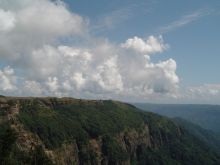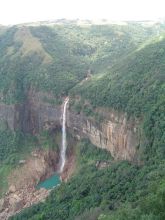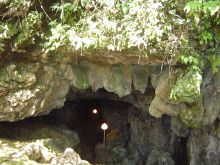 Meghalaya Links
Meghalaya LinksCherrapunjee & Mawsinram
CHERRAPUNJEE :
 With mesmerizing panoramic view of Hilly Terrains, Deep Gorges and Lush Green Valleys and located at the height of 1300 m above sea level, Cherrapunjee boasts for its abundant breathtaking scenic beauty. Cherrapunjee is the highly wettest place as it receives the second highest rainfall in the world. The monsoon clouds embrace and kiss the mountains as they swept accorss the plain of Bangladesh from Bay of Bengal and are coaxed to shed their moisture to drench the mountain in a deluge to provide home to one of the most bio-diversity rich vegetation in the world. Cherrapunjee or Sohra as it is locally known is 56 km away from Shillong. The beautiful town Cherrapunjee is a centre of Khasi Culture and Literature with having the oldest Presbyterian Church and an establishment of Ramakrishna Mission and famous for its Limestone Caves and orange and Pineapple groves. Approaching road to Cherrapunjee from Shillong, which passes through foaming rivers and rolling clouds passing by is one of the best roads in the country for Motor biking.
With mesmerizing panoramic view of Hilly Terrains, Deep Gorges and Lush Green Valleys and located at the height of 1300 m above sea level, Cherrapunjee boasts for its abundant breathtaking scenic beauty. Cherrapunjee is the highly wettest place as it receives the second highest rainfall in the world. The monsoon clouds embrace and kiss the mountains as they swept accorss the plain of Bangladesh from Bay of Bengal and are coaxed to shed their moisture to drench the mountain in a deluge to provide home to one of the most bio-diversity rich vegetation in the world. Cherrapunjee or Sohra as it is locally known is 56 km away from Shillong. The beautiful town Cherrapunjee is a centre of Khasi Culture and Literature with having the oldest Presbyterian Church and an establishment of Ramakrishna Mission and famous for its Limestone Caves and orange and Pineapple groves. Approaching road to Cherrapunjee from Shillong, which passes through foaming rivers and rolling clouds passing by is one of the best roads in the country for Motor biking.
Here the rainfall may vary from heavy to medium downpour and even drizzle. However, no month passes by without the rain. Another interesting fact about Cheranpunjee, Meghalaya is that it rains mostly at night here and much lesser during day.
Cheranpunjee is also famous for its variety of orchids, rare species of ferns and moss make the place as a botanist’s paradise.
NOHKALIKAI FALL :
One of the must visit places in Cheranpunjee is Nohkalikai Fall, which is fourth highest waterfall in the world. The Waterfall is 5 Km west of Cheranpunjee and towers to a height of 1100 ft. A clear fizzy stream emerges from its steep mountain bed to hurl down a stony precipice, into a deep gorge, creating an arresting view of the nature's bounty. 
A local legend is connected with the waterfall from which it has derived its name. Locally Nohkalikai Fall is called “ Fall of Ka Likai”. Nohkalikai Waterfalls is high on beauty quotient and is often compared with the famous Jog Falls of South India.
MAWSMAI CAVE :
Caving is an art which can be best experienced in the mystic Mawsmai Caves of Meghalaya. These Caves are fast becoming a hot tourists destination offering great adventure opportunity to the tourists. The caves are located near Cherrapunjee and are made of limestone makes spellbind the visitor the moment he enters the caverns. The entrance is well lit, but as one enters further inside, the eerie ness and the mystery, starts unfolding. The interior of the cave at Mawsmai in Meghalaya consists of big halls. Each of these halls looks like an amphitheater. The cave is embedded in darkness. But if lighted properly with the help of torch or any other source, their interior glows like a crystal. The only distinguishing point in all these halls is their varying shapes and sizes. Stalactite and stalagmite myriads lay scattered in the cave. The interior of the cave is quite spacious, which allows one to conveniently move about within the cave. The conspicuous pillars formed due to the joining of the roof and the floor are an awe-inspiring creativity of the creator of this world.
 With a length of 4503 m, this cave is at present, the 4th longest in the Indian sub continent. The other name for this attraction of Mawsmai at Meghalaya is Krem Phyllut. It is located close to the Nohsngithiang Falls. The entry point of Mawsmai Cave is located in the village of Mawsmai. According to the legend the Mawsmai Caves were discovered by the Khasi tribesmen while they were out for hunting. Initially the caves housed several animals which were later hunted down by the tribe.
With a length of 4503 m, this cave is at present, the 4th longest in the Indian sub continent. The other name for this attraction of Mawsmai at Meghalaya is Krem Phyllut. It is located close to the Nohsngithiang Falls. The entry point of Mawsmai Cave is located in the village of Mawsmai. According to the legend the Mawsmai Caves were discovered by the Khasi tribesmen while they were out for hunting. Initially the caves housed several animals which were later hunted down by the tribe.
LIVING ROOT BRIDGE :
Around 1500 ft. below the village of Laitkynsew near Cherrapunjee, is the most accessible example of Khasi Bi-engineering footbridge construction. Cobbled stone pathway goes down steeply from the village. Measuring about 53 ft Umnnoi Living Root Bridge is above 100 yrs old and constructed over small stream to be used daily by the villagers.
The lower riches of the southern slopes of the Khasi and Jaintia hills are humid and warm and are streaked by swift flowing rivers and streams. A special rubber tree called Ficus Indicus flourishes alongside these rivers and streams which has exuberant root growth from all parts of tree base, trunk and upper limbs. The tree usually perched on rocks and are reaching out to soil for nourishment. Thus they have adapted themselves well to high soil erosion, caused by these fast flowing rivers and streams. These exposed root grow strong and reach out over long distance from the tree trunk. By strategic planting and training of this tree the Khasi, Jaintia and Garo canyon dwellers have perfected this superbly effective solution to maintaining safe access to their villages all year round.
No timber constructed bridge would survive the seasonal battering of these water courses nor the depredations of the ubiquitous white- ant colonies living in these jungles. The principal construction root runs may be up to 18 inches, 45 cm, thick. The guard rails are high and intricately woven. These routes are the only access for all materials going up or down. The legal maximum pack weight for coolee work is 40 kilos. With this load high on a coolee's back good substantial hand rails are required.
These bridge s probably take 20 to 25 yrs to become fully functional. They keep growing in strength by the day. Perhaps their life span is 200 to 300 yrs after the bridges are well formed. These bridges are eloquent testimonies of man living in harmony with nature. A unique Double Decker Root Bridge in the vicinity has one deck 70 feet long and another 56 feet long. This must be the only one kind in the entire world.
MAWSYNRAM :
Mawsynram, which offers the heavenly beauty is in the Khasi Hills. Mawsynram is also famous for the maximum wettest place as it receives the highest rainfall in the world. It is located near Cherrapunjee. Noh Kalikai Fall, which is the fourth highest fall in the world is near Mawsynram. Mawjymbuin cave is located here. The cave has a naturally fashioned Shivalinga made by Stalagmite is truly noteworthy. Symper Rock is another attraction which is a loaf-shaped rocky dome with an almost flat roof.

 Back to Previous Section
Back to Previous Section